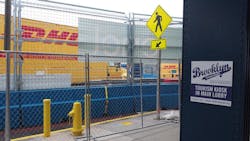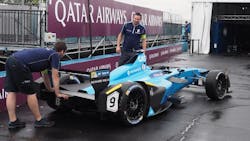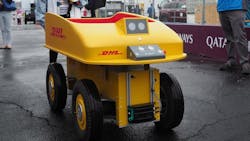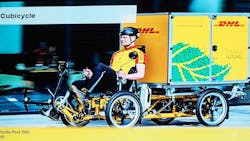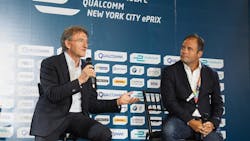The big Formula E race show — and DHL's cleaner, technology-fueled future
BROOKLYN, NY. Call it a major PR push to show off the potential of electric vehicle power — or maybe even the need, someday, to have only those — and much more as technology and logistics rapidly evolve. Package-delivery giant DHL, Germany's post office, went to work for the Formula E electric race series' first appearance in New York City, highlighting the eco-logistical feat of the race's low-pollution, ground-focused shipment and arrival here.
That included transporting 450 tons of equipment freight made up of 40 cars, 45 large, high-voltage lithium ion batteries for them, 20 chargers, broadcast and media equipment, race infrastructure and more to a dense urban location for this weekend's all-electric racecar Qualcomm ePrix.
Ken Allen, CEO of DHL Express, touched on the air freight point in a press briefing during the race's final setup. A promo image up in the background showed a Formula E car with two DHL airliners behind it.
"It's our vision that by 2050, those planes will be either electric planes — and that is not a far-fetched thought — or they'll be running on fuel that is not carbon-emitting," he said. "It's part of the big picture that we've got."
Roll that in with DHL's stated goal of reaching carbon-neutral/ zero-emission logistics by 2050 and a 30% carbon efficiency improvement target the company just reached three years early. Such change and ideas indeed aren't much of a stretch for DHL, which has its hands in just about every latest-buzz mobility technology today.
For instance, DHL recently pulled an automotive-world upset by getting into production of its own electric delivery truck, the StreetScooter, and hopes to roll 20,000 of those off the line by the end of the year. Meanwhile, the company has also been testing the vehicle's autonomous operation.
So look closer, and this is also a game of hearts and minds. Rather than the "softie" image that can plague environmentally-friendly technologies like electric cars and trucks, first of all, the eco-friendly Formula E races bring super-fast cars on par with roaring Formula 1 machines. They merge new technologies like more powerful, quicker-charging electric vehicle batteries with greener mobility and transportation concepts.
Technology on every edge
Thus the Formula E show for which DHL is doing much of the backstage work actually goes beyond just the race. "What we saw here was entertainment that creates value for society," Allen noted. It's an entertainment venue that DHL, a founding and the official logistics partner, is using to help change the public's view and raise awareness of electric power for vehicles but also of an environmentally cleaner, increasingly connected and all-new technological world.
No, really: From this year's front-running alternate fuel to delivery drones, self-driving vehicles, assistive robots, new supply chain models and augmented reality to digitization and globalization of small business, DHL has its sights — and many minds at work in-house — on it all.
And the company engages the Formula E race crowd about many of those things. A Microsoft HoloLens virtual/augmented reality experience demonstrates the arm-like robot that can sort packages at DHL facilities. The company is also showcasing how its workers have been using AR goggles to find and arrange items on picker carts to reduce errors and boost warehouse efficiency by 25%.
That DHL cart they're loading — an EffiBOT, the company's autonomous, small-flatbed/ wagon robot that can haul more than 650 lbs. — follows Formula E staff, too, trucking parts and supplies around or even making appearances with fans. Also regarding mechanized freight movement, DHL's Allen talked drone delivery, noting that the company has found aerial drones most useful so far in reaching remote areas.
Of course, DHL also operates and innovates in the many tight, pedestrian- and alt-transportation-filled streets of European cities. One of the company's new logistics developments there is the Cubicycle, an electric-power-assisted urban delivery bike that can haul a package volume of 1 cubic meter and 150 kg/330 lbs. and sits low enough that it minimally obscures the view of bicyclists. A container trailer vehicle delivers four of the "cubes" to the bikes and acts as a mobile distribution hub.
DHL is aiming for 70% of its first- and last-mile operations by 2025 to be completed by green methods like such bike and electric vehicles. In terms of access points and distribution, DHL has also tested trunk-based delivery — allowing people to pick up items on-location — in exploring an alternate last-mile services idea.
Allen directed media toward smaller businesses and their ability to reach out digitally to expand their offerings worldwide. "I think it's really important that we promote small and medium-sized businesses around the world, because this is going to be the future of commerce," he said. "Today, from Day One you can go international if you've got a good idea."
Lightning strikes diesel?
Formula E and its underlying philosophies align with sustainable mobility tech and reducing fossil fuel consumption, perhaps imagining the post-internal combustion engine days to come. So at least has gone the thinking of major automakers like Volvo, which has pegged 2020 for all its new vehicles introduced to be electric or hybrids, to governments such as those in France and Norway, which recently targeted 2040 and 2025, respectively, to end sales of new gasoline and diesel vehicles.
But in trucking, particularly in the United States, can the entrenchment of diesel power ever truly be challenged, and does electric power stand a chance as more than a blip? Two years or so of consistently low oil and related fuel prices have helped contribute to everything from a ho-hum lack of interest in alternate fuels in transport to booming larger-vehicle sales and more clothes and textiles made of synthetic fibers.
"It's a long journey. You can't change everything overnight," Allen told Fleet Owner. "For example, if we could stop fossil fuel emissions tomorrow, what would happen to all the economies, jobs and everything else around the world that's dependent on that?
"I think it's all about creating communities, about raising awareness, and saying, 'Look, we can't keep emitting like we do at the moment,'" he continued. Still, he noted, in the world of parcel delivery and e-commerce, the potential is there for electric power.
"I think that on the ground, there's no doubt about it. Over the next 5-10 years the technology is there that every ground delivery vehicle, starting with the smaller ones, could be electric," Allen said. "Other vehicles could come in time."
He compared harmful emissions and pollution essentially to cigarettes, and their journey from accepted, very common societal norm to now being much more limited. That only happened after much data and studies on smoking and its risks, awareness campaigns, businesses and airlines eliminating indoor smoking, and government regulation and taxes eventually changing.
Ali Russell, head of media relations and business development director for Formula E, noted that interest in electric vehicles and the races — and participation from manufacturers — has grown sooner than expected. He pointed to OEMs including Audi, BMW, Jaguar, Renault and Citroen as well as electric vehicle-specific newcomers like Faraday Future.
"You can see there's a lot of growth in appetite for the manufacturers to get involved. I don't think it's one single point; I think what we're doing is we're creating a global network and trying to knit together different parts of the world and different governments," he said at the briefing.
"From a Formula E point of view," he added, "it's taking one city at a time, one country at a time and handling it, because they're all different."
About the Author
Aaron Marsh
Aaron Marsh is a former senior editor of FleetOwner, who wrote for the publication from 2015 to 2019.

